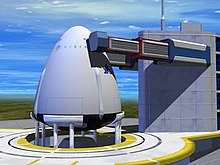Kankoh-maru
Appearance
 Artist's concept of Kankoh-maru | |
| Function | Crewed re-usable rocket |
|---|---|
| Country of origin | Japan |
| Size | |
| Height | 23.5 m (77 ft)[1] |
| Diameter | 18 m (59 ft)[1] |
| Mass | 550 t (1,210,000 lb)[1] |
| Stages | 1 |
| Capacity | |
| Payload to LEO | |
| Mass | 4 t (8,800 lb)[2] |
| Launch history | |
| Status | Proposed[2] |
| First stage | |
| Thrust | 6,888,000 N (1,548,000 lbf) [1] |
| Boosters | |
| Total thrust | 2,900,000 N (650,000 lbf) [1] |
The Kankoh-maru (観光丸, Kankōmaru) is a proposed vertical takeoff and landing (VTVL), single-stage-to-orbit (SSTO), reusable launch system (rocket-powered spacecraft). According to a document from July 1997, it would have been manufactured by Kawasaki Heavy Industries and Mitsubishi Heavy Industries, with its formal name being the Kawasaki S-1.[1]
Overview
The concept was created by the Japanese Rocket Society [ja] in 1993.[2][need quotation to verify] This development cost was estimated ¥2.67 trillion ($28 billion) in 1995.[2][need quotation to verify]
The name Kankō Maru is derived from the first steam-powered vessel in Edo-era Japan.[2]
See also
- Chrysler SERV
- VentureStar
- Reusable Vehicle Testing program by JAXA/ISAS
- Blue Origin New Shepard
- Falcon 9 Full Thrust
References
External links
- Encyclopedia Astronautica entry
- 宇宙旅行アーカイブ (Space Tourism Archive), Space Liner Association
